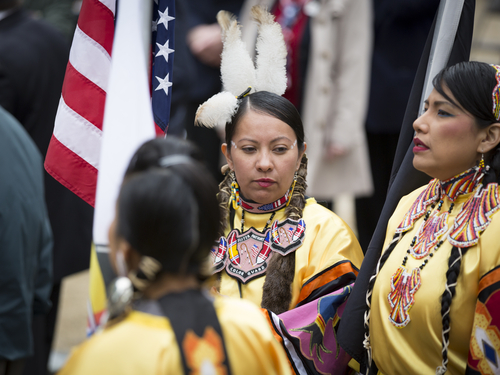U.S. Relations
By 1853, the entirety of what we now call the Southwestern United States was under the control of the U.S. The United States recognized the Spanish land grants, and thus the Indian groups along the Rio Grande retained their land grant rights. However, other tribes had constant encroachment on their lands. With the discovery of gold in the west, and the expansion of settlers westward, conflict between the U.S. and tribes was inevitable. Much of the problem stems from the fact that the land appeared "empty" and "unused" by the Anglos; however, these seemingly "vacant" tracts of land were important hunting and gathering lands used by the semi-nomadic tribes that lived in much of the area. As Native Americans lost access to these areas, they increasingly turned to raiding of Anglo mining camps and settlements as an economic mainstay. The U.S. Army retalitated with campaigns to subdue the tribes.
Tribal Sovereignty
By the late 1800s, most tribes had signed treaties with the U.S. government in which they promised to cease raiding and warfare and to relinquish their claims to the lands. In return, the U.S. promised to
(a) set aside reservation lands for the tribe,
(b) provide certain forms of government assistance, and
(c) recognize tribes as sovereign entities.
Thus, it is from these treaties that the concept of tribal sovereignty derives. Although most Americans are unfamiliar with the concept, tribal sovereignty means that Native Americans have the right to govern themselves, and that reservation lands are not subject to state laws. (This is why reservations can operate casinos, even in states where casinos are illegal). Tribes are not fully equivalent to foreign sovereign nations, however—their rights can be limited by Congress, but only by Congress. (Note: today, Native Americans are considered citizens of both the U.S. and their own tribe. Like all other U.S. citizens, they pay taxes, have the right to vote, can serve in the military, etc. Tribal sovereignty simply means that the tribes have the right of self-governance within the boundaries of the reservation.). Tribes continue today to receive certain types of assistance from the U.S. government (for example, in health and education matters) as a result of the terms of these treaties, which required the U.S. to do so.

|
Members of federally recognized tribes have something akin to (though not exactly like) a dual citizenship. They retain membership in their sovereign tribe as well as enjoy the full rights and responsibilities of any other United States citizen. |
By the 1880s, virtually all Southwestern tribes were confined to either reservation lands or the Spanish land grant areas. However, there was a growing dissatisfaction of this policy that had encouraged Native Americans to live separately from and remain separate from the remainder of the U.S. society. For a variety of reasons (which we shall discuss in coming modules), making a living was difficult on most reservations, and few Native Americans had achieved self-sufficiency. They relied, instead, on government assistance (which was required as a part of the treaty agreements).
Thus, in the 1880s U.S. policy toward Native Americans shifted from one of separation (i.e., keeping Indians on the reservation) toward one of assimilation and acculturation. Reflecting this shift, in 1887 the Dawes Act was passed. This act gave the President of the United States the power to allot the lands within reservations to Native Americans and to sale off surplus reservation lands to non-Indians. This act was probably well intentioned- the goal was to replace the Indian concept of communally held lands with that of private property, with the idea that Indians would better prosper if they adopted Anglo concepts and values. However, the Dawes Act was devastating to tribes-- some tribes lost as much as 60% of their lands to non-Indians as a result.

Source:By United States Department of the Interior [Public domain], via Wikimedia Commons
http://hrmdeborah.blogspot.com/2009/02/geronimos-kin-sue-skull-and-bones-over.html
Click next page to continue.
